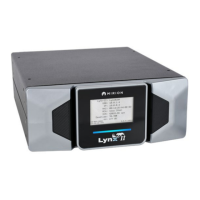Chapter 5 Web-Based Operations
88 Lynx II DSA User's Manual - 7096089
Digital Traces
The trigger traces are displayed in the lower plot of the DSO display. Any combination
of the digital traces can be enabled or disabled through their respective checkboxes to
simplify the display. Digital Traces include:
• Peak Detect – This signal displays the status of the spectroscopy filter peak
detector. The signal goes low when the signal crosses the slow discriminator
threshold level and begins searching for the peak signal amplitude. The signal goes
high when the system has detected the peak amplitude.
• Slow Discriminator – This signal displays a status of slow (Spectroscopy) filter
discriminator signal. This signal is high when the amplitude of the filter level is
above the slow discriminator threshold level.
• Fast Discriminator – This signal displays the status of the fast filter (Pileup)
discriminator signal. This signal is high when the amplitude of the filter level is
above the fast discriminator threshold level.
• BLR Gate (Baseline Restorer) – This signal displays the status of the slow
(Spectroscopy) filter baseline restorer gate. Baseline restoration is gated off when
this signal is high and active while this signal is low
• Store – This signal goes high when a pileup-free event is detected in the slow filter.
The event will be stored in the spectrum if the system is acquiring and meets all
storage qualifications the user has established including LLD, ULD, Coincidence
gating, etc.
• External Gate In – This signal goes high while the external gate input is at its
active (coincidence) level and low when the gate input is at its inactive level
(anticoincidence).
• Reject – This signal goes low when pileup events are detected.
• Inhibit – This signal goes high during inhibit conditions such as a TRP Inhibit or an
energy signal overload. It can be used to aid in the adjustment of the preamplifier
inhibit signal.
Print DSO Plot
Click on this button to display or print the DSO plot.

